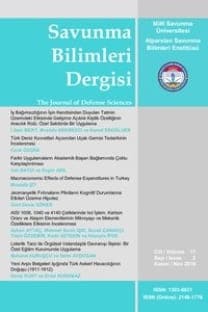Examining the Geography of Logistic Points in "The Great Assault" of the Turkish War of Independence Using Spatial Statistics
Savaşın ve savaş lojistiğinin mekânsal boyutları üzerinde yapılmış olan çalışma sayısı sınırlıdır ve bu çalışmaların hiçbirinde mekânsal istatistik teknikleri kullanılmamıştır. Bu çalışmada, Kurtuluş Savaşı'nın "Büyük Taarruzu"ndaki lojistik noktalarının temel mekânsal istatistik ölçütlerinden olan (1) ortalama merkez, (2) standart sapma elipsi ve (3) en yakın komşu analizi teknikleri ile incelenmesi hedeflenmiştir. Çalışmada amaç, mekânsal istatistik yöntemlerinin, savaş lojistiğinin mekânsal boyutunun daha iyi anlaşılmasında yardımcı olabileceğinin ortaya konmasıdır. Çalışmadan elde edilen sonuçlar "Büyük Taarruz"da kullanılmış olan lojistik noktalarının mekânsal olarak rastlantısal olmadığını istatistiksel olarak ortaya koymaktadır. Çalışmada Türkiye Cumhuriyeti'nin başkenti olarak neden Ankara'nın seçilmiş olduğu da mekânsal istatistik yöntemleri ile ortaya konmuştur
Kurtuluş Savaşı'nda "Büyük Taarruz"da Lojistik Noktalarının Coğrafi Dağılımının Mekânsal İstatistik Yöntemleri Kullanılarak İncelenmesi
There are limited number of studies that focus on the spatial aspects of war and logistics, and none of the studies have utilized the methods developed within the spatial statistics framework. This paper examines the spatial distribution of logistics points in "The Great Assault" of the Turkish War of Independence using three basic measures of spatial statistics: (1) mean center, (2) standard deviational ellipse, and (3) the nearest neighbor analysis. The aim is to show that the tools developed within framework of spatial statistics can be used for a better understanding of the spatial dimension of war logistics. The results from the spatial analyses prove statically that the spatial decisions made in "The Great Assault" of the Turkish War of Independence were not random and had a measurable spatial dimension. The results also show that spatial statistics can also be used to explain why Ankara was selected as the new capital city of the emerging Republic of Turkey
___
- Black, J. (1997). Maps and politics. London: Reaktion Boks Ltd..
- Clark, P. J., and Evans, F. C. (1954). Distance to nearest neighbor as a measure of spatial relationships in populations. Ecology, 4, 445-453.
- Çubukçu, K.M. (2015). Planlamada ve Coğrafyada Temel İstatistik ve Mekânsal İstatistik. Nobel Akademik Yayıncılık. Ankara.
- De Reu, J., De Mulder, G., Van Strydonck M., Boudin, M., Bourgeois, J. (2012). 14C dates and spatial statistics: Modeling intrasite spatial dynamics of Urnfield cemeteries in Belgium using case study of Destelbergen cemetery. Radiocarbon, 54(3-4), 635-648.
- Ebdon, D. (1985). Statistics in geography: A practical approach, 2nd edition. Oxford: Blackwell Publishing.
- Howard, D. A. (2001). The history of Turkey. Westport, CT: Greewood Press.
- Karakuyu, M. (2011). A new approach to analyzing historical urban growth of Ottoman cities: Manisa case study. Historical Methods, 44(3), 131- 138.
- Knowles, A. K. (2008). GIS and history. In Placing history: How maps, spatial data, and gis are changing historical scholarship, edited by A. K. Knowles, and A. Hillier, 1-27. Redlands, CA: ESRI Press.
- Lewis, B. (2002). The emerge of modern Turkey, 2nd edition. London: Oxford University Press.
- Muderrisoglu, A. (1990). Kurtuluş Savaşı'nın mali kaynakları. Istanbul: Ataturk Arastirma Merkezi.
- North Atlantic Treaty Organization (NATO) (1997). Logistics handbook, Annex A. Brussels: NATO Headquarters.
- Pal, S.K. (1998). Statistics for geoscientists: Techniques and applications. New Delhi: Concept Publishing Co.
- Satyanarayana, P. S., and Yogendran (2002). Military Applications of GIS. GIS Lounge, August 27, 2002, accessed October 12, 2014, http://www.gislounge.com/military-applications-of-gis/.
- Timur, C, Atakan, R., Berktay, A. (1975). Türk istiklal harbi VII. Cilt: İdari faaliyetler 15 Mayıs 1922 - 02 Kasim 1923. Ankara: Genelkurmay Başkanlığı
- Van Creveld, M. (2004). Supplying war: Logistics from Wallenstein to Patton, 2nd edition. New York: Cambridge University Press.
- Ward, M. D., Gleditsch, K. S. (2002). Location, location, location: An MCMC approach to modeling the spatial context of war and peace. Political Analysis, 10(3), 244-260.
- Wong W.S.W., Lee, J. (2005). Statistical Analysis of Geographic Information with ArcView GIS and ArcGIS. Hoboken, NJ: John Wiley and Sons, Inc.
- Yuill, R.S. (1971). The standard deviational ellipse: An updated tool for spatial description. Geografiska Annaler. Series B, Human Geography, 53(1), 28-39.
- ISSN: 1303-6831
- Yayın Aralığı: 2
- Başlangıç: 2002
- Yayıncı: Milli Savunma Üniversitesi Alparslan Savunma Bilimleri ve Millî Güvenlik Enstitüsü
